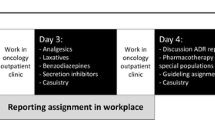Abstract
“Boxed warnings” (BW), sometimes referred to as “black box warnings,” are the most serious level of warning provided by the Food and Drug Administration (FDA). We aimed to assess physician awareness and knowledge of BW, and to gain a better understanding of where physicians obtain information about serious adverse drug reactions for commonly prescribed medications. A cross-sectional survey instrument was administered to emergency medicine (EM) and pediatrician (Peds) attending and resident physicians. The main outcome measures were physician performance in identifying medications with and without black box warnings and the content of the warnings. The survey response rate was 81/198 (41 %). Respondents correctly identified medications with BW only 36.3 % of the time, but were able to correctly identify medications without such warnings 83.8 % of the time. Attending physicians were better able to identify medications with or without BW when compared with residents (p < 0.05). Among residents, there was a statistically significant increase in the ability to identify medications with or without BW with increasing year of training (p < 0.01). Correct identification of the content of BW was low in both groups (13.3 %). Only 19/50 (37 %) EM physicians and 16/31 (52 %) Peds reported that they consider BW when prescribing medications. 23/81 (29 %) respondents indicated that they did not stay current or had no method of staying current with black box information. EM and Peds attending and resident physicians at a single institution had limited ability to identify medications containing BW or the content of such warnings. A significant number reported that they did not stay current or had no consistent method for staying current with BW.
Similar content being viewed by others
References
Warnings and precautions, contraindications, and boxed warning sections of labeling for human prescription drug and biologicla products [internet]. 2011 [cited Sept. 2015] Available from: http://www.fda.gov/Drugs/GuidanceComplianceRegulatoryInformation/Guidances/ucm065010.htm.
Cheng CM, Shin J, Guglielmo BJ. Trends in boxed warnings and withdrawals for novel therapeutic drugs, 1996 through 2012. JAMA Intern Med. 2014;174(10):1704–5.
Kloet MA, Lohr BR, Smithburger PL, Seybert AL, Kane-Gill SL. Prospective assessment of inpatient boxed warning prescriber adherence. J Patient Saf. 2014.
Lasser KE, Seger DL, Yu DT, Karson AS, Fiskio JM, Seger AC, et al. Adherence to black box warnings for prescription medications in outpatients. Arch Intern Med. 2006;166(3):338–44.
Moeller KE, Shireman TI, Generali J, Rigler S, Mayorga A. Pharmacy students’ knowledge of black box warnings. Am J Pharm Educ. 2010;74(1):5.
Haloperidol package insert [internet].[cited Sept 2015] Available from: http://dailymed.nlm.nih.gov/dailymed/.
Cheng CM, Fu C, Guglielmo BJ, Auerbach AD. Boxed warning inconsistencies between drug information resources and the prescribing information. Am J Health Syst Pharm. 2011;68(17):1626–31.
Author information
Authors and Affiliations
Corresponding author
Ethics declarations
Conflict of interest
Authors Craig Smollin, Jonathan Fu and Ross Levin declare that they have no conflicts of interest.
Electronic supplementary material
Below is the link to the electronic supplementary material.
eTable 1
(DOCX 16 kb)
Rights and permissions
About this article
Cite this article
Smollin, C.G., Fu, J. & Levin, R. Recognition and Knowledge of Medications with Black Box Warnings Among Pediatricians and Emergency Physicians. J. Med. Toxicol. 12, 180–184 (2016). https://doi.org/10.1007/s13181-015-0519-3
Published:
Issue Date:
DOI: https://doi.org/10.1007/s13181-015-0519-3



